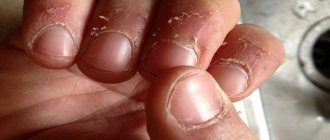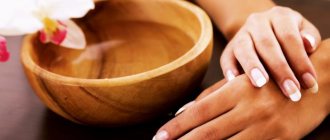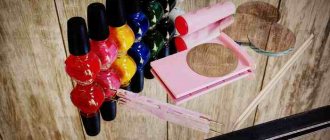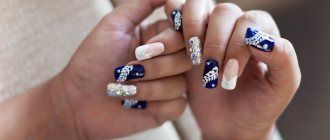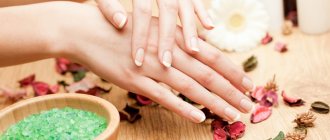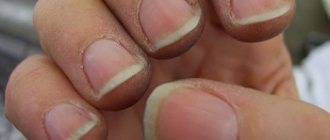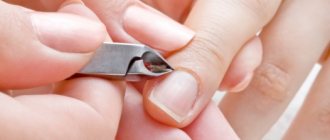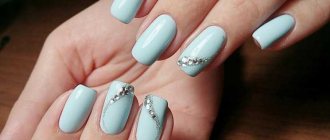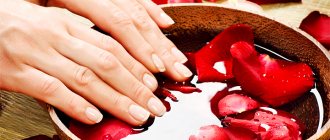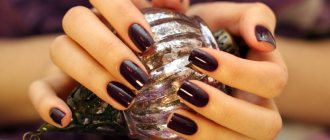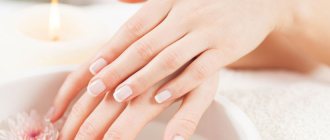In this article we will analyze everything about the cuticle: how to cut it, process it and care for it.
Artists, poets and ordinary men have always admired sleek ladies' hands. An important element of graceful hands is well-groomed nails, in the design of which the cuticle, by the way, plays an important role. It can be called the “gray eminence” of a successful image, which is not visible, but the general appearance of the hands and the impression of their well-groomedness depends on how it is processed. For example, I like my nails without polish, but only if they are well-groomed. And, on the contrary, a very beautiful decorative coating, in my opinion, looks sloppy and vulgar if the fingers are not processed.
Remember the stunning image of the first lady from the series “House of Cards”. She is played by the gorgeous Robin Wright, and there are no small details in the image created by the actress. Perfectly manicured nails are one of those details that create the image of an impeccable woman.
Regardless of what methods of care you prefer, in my opinion, you must in any case be able to do all the procedures yourself. This helps you save time, money, always be in great shape and feel confident.
Should I trim my cuticles or not?
Until recently, only the classic manicure was in use - edged, when the cuticle was completely removed from the nail. Nowadays, European manicure – unedged – is gaining more and more popularity.
The advantages of trimmed, American manicure are obvious:
- nails visually become longer, this gives them a beautiful, well-groomed appearance;
- Trimming manicure is recommended if the nail is damaged or growing in some way incorrectly.
Minuses:
- removing cuticles with scissors has long been recognized as unsafe: if some kind of infection or dirt gets inside during or after the procedure, you can get inflammation;
- with inept work it is easy to cut yourself until you bleed;
- you can also scratch the nail plate itself;
- The more often and more thoroughly we remove the cuticle, the faster it grows back and the denser and tougher it becomes.
Advantages of the European manicure:
- it’s simple, you can do it at home without the help of a manicurist;
- it is safe, because during such an operation the cuticle is not damaged;
- accordingly, such care for the cuticle helps it perform its main function, and the nails remain protected from external irritants and bacteria;
- keratinized, old skin cells still die and gradually separate from the nail.
There are practically no disadvantages to European manicure:
- The only thing is that you won’t be able to switch to an unedged manicure immediately after a trimmed one; you will have to go through several sessions of a European manicure until the cuticle begins to look neat and aesthetically pleasing.
Why do you need a cuticle?
Photo by cottonbro: Pexels
Any soft protective shell is called a cuticle. When it comes to nails, this term refers to the thin, soft skin that covers the base of the nail. This is what is cut off during a trim manicure so that your fingers look perfect. The cuticle performs an important protective function. This thin skin protects the nail bed from injury and infection.
If it weren't for her, my nails would be more susceptible to fungi and bacteria, would be more injured during housework, and would generally be very vulnerable. Penetration of infection to the base of the nail weakens it and quickly leads to destruction of the plate.
In general, the area under the nail is a favorable environment for the growth of bacteria and fungi, therefore, if it were not for the cuticle, it is unlikely that a person could have such beautiful and healthy nails as they do now.
However, the cuticle causes a lot of trouble. It can be very hard and rough, and there are many capillaries in it, so any damage leads to bleeding. If you've ever accidentally cut your cuticle, you probably know how long it takes to bleed from the slightest wound. The second common problem is the unsightly “fringe” that thin and soft cuticles are prone to as they grow back. This small nuance greatly spoils the appearance of the fingers.
How to prevent the cuticle from growing?
How to do edged and unedged manicure
If you still opt for a trimmed manicure, it is better to have it done in a professional salon. Although many can do it at home.
Recommendations for removing cuticles:
- Step 1. First, treat your hands and all used manicure tools with a disinfectant, remember: trimmed manicure is really dangerous and can cause infection.
- Step 2. Shape your nails: it is very important to do this before working with the cuticle, because a softened nail cannot be processed with a file, it will begin to flake and break.
- Step 3. Make a softening bath, immerse your fingers in it for 10-15 minutes, and then apply a special cuticle softener.
- Step 4. When the cuticle has become soft and ready for further procedure, carefully push it away with a pusher, being careful not to scratch the nail.
- Step 5. Cut the cuticle with scissors or special tweezers.
- Step 6. At the end, be sure to treat the nail and skin around it with some nourishing oil or regular fatty cream.
Compresses
This method will help if you don’t know how to quickly soften a large toenail.
It has many advantages:
- Stronger and faster effect.
- Long-term exposure to the affected area.
- Any suitable solution or ointment can be used.
The compress is usually applied overnight. A cotton pad with medicine is placed on the nail, a film is secured on top and wrapped with a bandage. There are several compress options.
With aloe leaf
The most convenient way. A peeled aloe leaf is applied to the nail, covered with a film and secured with a bandage. The compress remains on the finger until the morning. In the morning, the softened nail is cut off.
We recommend reading:
Another option: peel the aloe leaf and grind it with 20 g of softened butter. The mixture is also applied at night using a compress. You will need 3 or 4 such procedures, after which the nail can be easily cut off.
With vinegar
A compress with vinegar softens well. But, it cannot be used on scratches and wounds. The procedure requires a 9% solution of ordinary table vinegar (can be replaced with apple cider vinegar).
Soak a napkin with the liquid and apply it to the problematic nail. Cover the top with film and wrap it with a bandage.
It is convenient to use a plaster instead of a bandage. The compress can be kept for no more than 3 hours. Afterwards, try to trim the nail with scissors.
If the above methods do not help, then you need to use ointments.
So different: how to work correctly with different types of cuticle
The cuticle is a real “fine matter” of manicure art. It can be healthy or problematic, and for any type of cuticle it is very important to choose the right manicure. How to remove the cuticle correctly and not cause harm to the client?
Dry cuticle: how to remove and care
How to work with wet cuticle correctly
What to do if the cuticle is “creeping”
How to treat tight cuticles
How to cure injured cuticle
Dry cuticle: how to remove and care
Dry cuticles can be a real headache for its owner. A dry, unmoisturized cuticle protects the area around the nail less well, and hangnails are more likely to appear on it. And this creates a threat of inflammation and even fungal diseases. Needless to say, dry cuticles make your nails look simply untidy?
A nail technician should be careful when treating dry cuticles. A trimmed manicure is not suitable - when removing with scissors or a tweeter, there is a risk of damaging thin skin. Due to closely spaced capillaries, the cut cuticle may begin to “bleed,” which is not only painful, but also fraught with infection.
The best option for working with dry cuticles is a hardware manicure. With the help of a properly selected cutter, pterygium can be cleaned off without harming the sensitive cuticle. After all, with this method, the keratinized skin is not cut off, but carefully polished.
In the future, the dry cuticle should be treated with a special oil. Organic products based on sweet almond and jojoba oils and moisturizers are perfect. Additionally, it is imperative to remind the client to avoid contact with chemicals and hard water without gloves. It is precisely this aggressive environment that most often leads to dry nails and cuticles. However, it can also be due to problems in the body such as stress, malnutrition and even certain medications.
How to work with wet cuticle correctly
Wet cuticles may be associated with hand hyperhidrosis. It is highly elastic, so it should be removed with extreme caution. If handled roughly, the wet cuticle may tear!
A combined manicure is best for wet cuticles. Before removing such a cuticle, it must be dried. This will make it much easier to remove dead skin. After this, the cuticle is pushed back with a pusher, and the pterygium is cleaned with a cutter.
Cleaning with a cutter should be done in such a way as to lift the wet cuticle. This will make it much more convenient to cut it with manicure scissors. At the end of the treatment, the cuticle and side ridges are polished with a milling cutter with a soft corundum attachment.
What to do if the thinned cuticle “creeps”
Thin cuticles tend to grow on the nail plate and can crack over time. Not only does this make your nails look unpleasant, but there is a risk of inflammation and infection. Such a “creeping” cuticle requires especially careful care!
During a manicure session, the growing cuticle is lifted with a cutter, the pterygium is cleaned, and the side ridges are polished. The cuticle itself should be carefully cut with nail scissors or a tweeter along the growth line - this way it will grow correctly in the future.
The client can take care of growing cuticles at home. To do this, you need to move it away from time to time with an orange stick. Before doing this, it is better to soften the cuticle with special oil.
How to treat tight cuticles
If the cuticle is very dense, working with it can make the specialist sweat. Sometimes an unedged, European manicure is enough. However, not every master will be able to successfully push back the cuticle and leave the client with a result they like. Therefore, you can combine edged and European methods.
To remove thick cuticles, it is recommended to use special removers. The remover is kept from a few seconds to five minutes (depending on the product). During this time, it will thin the keratinized skin, and its roughest areas can be cut off. The remaining part of the cuticle is pushed back with an orange stick or pusher.
To soften rough cuticles, you can regularly lubricate them with peach cuticle oil.
How to cure injured cuticle
Not all clients are able to keep their hands in perfect condition. Due to injury, illness or common bad habits, the area around the nail can become damaged. Burrs, wounds and cracks may appear on the cuticle and side ridges. Therefore, the master needs to be as careful as possible!
Damaged cuticles are treated exclusively with trimmed manicure. The hardware method will not work - when grinding with a cutter, there is a risk of further injuring the cuticle. If there are open wounds, the periungual area must be treated with an antiseptic. Burrs and cuticles are cut off with nail scissors.
To help problematic cuticles heal faster, you can use natural cuticle oils. Products enriched with vitamins and intended for particularly sensitive skin are best suited. After a manicure session, it would not be superfluous to refer the client to a dermatologist. A medical professional will be able to conduct the necessary examination and prescribe treatment. After all, health is the key to beautiful and graceful hands!
Home Remedies
Almost all of the above procedures cannot be carried out without special products, be it a scrub or oil. They can be purchased at cosmetic stores, or you can prepare them yourself from natural and affordable ingredients, combining those components that are suitable and appealing to you. There are several types of cuticle care products, each of which has a specific recipe that can be changed at your discretion.
Oil
The use of oils in the care of nails and the skin around them is one of the most valuable procedures. With their help, you can moisturize and nourish the cuticle, as a result of which trimmed manicures and pedicures will forever cease to be a necessity. The most valuable cuticle oils are:
- olive;
- almond;
- peach;
- wheat germ.
You can mix any of them with each other in arbitrary proportions, or use one as an independent remedy. The mixture can be enriched with a couple of drops of orange, lemon, ylang-ylang, lavender or other essential oil. Apply the mixture with a thin brush to the entire area around the nail, gently massage and allow the residue to be absorbed.
Wax
Wax is necessary mainly to nourish the skin. Specialized stores offer a fairly large selection of types of products with various additives and aromas. But it is very easy to prepare it yourself. To do this, you need to melt a small amount of natural beeswax in a water bath and pour it into a small jar. Add two drops of grapefruit essential oil (or any other), mix thoroughly and put in the refrigerator until completely solidified. This product is used as a massage product.
Scrub
In fact, it is not at all necessary to purchase a special cuticle scrub or prepare it at home. An exfoliator designed for the face is perfect. But if you still want to have an absolutely natural version of the scrub, then you can make it in a matter of minutes. You can use any base oil or even just a small amount of liquid soap as a basis. You need to add either sugar or very finely ground coffee beans. Their size should be such that it cannot injure the delicate skin around the nail. You need to scrub each finger separately, spending at least 50 seconds on it. The effect of smoother, hydrated skin will be noticeable after the first use, and after some time you will be able to observe faster nail growth.
Balm
Cuticle balm is a worthy alternative to oil. But this does not mean that you cannot take care of your skin using these products together, alternating them. On the contrary, it will only be beneficial. The easiest option is to take a regular colorless lip balm and apply it with massaging movements to the cuticle. This method will be convenient when traveling, when it is inconvenient to take several care products with you at once. For home use, you can prepare the product according to the following recipe: cut off a piece of lip balm, melt it, pour it into a container, enrich it with a couple of drops of any essential oil, and let it harden in the refrigerator. The balm should be used daily.
Thus, we can say that the cuticle care procedure does not take much time and money. It is not at all necessary to visit a specialist, and you do not even need to purchase special products. You can spend just a few minutes a day to forget forever about the ugly, rough skin that grows on your nails and spoils your manicure and pedicure.
How to slow down cuticle growth
For slow cuticle growth, the European method of manicure is preferable: a pushed back cuticle slows down in growth, while a cuticle trimmed in the American style, on the contrary, tends to grow faster.
There are specialized means to slow down the growth of the skin fold. Most often these are gels or oils. Usually they need to be rubbed into the cuticle before going to bed. If you follow this advice, you will soon notice that the cuticle really does not grow so quickly.
These products have other advantages: they usually contain various nutrients and vitamins that help nails stay healthy and strong.
Benefits of the remover
Trimming manicure is associated with many inconveniences. To avoid them, you can use a remover. However, like any cosmetic product, it has its advantages and disadvantages. The advantages of the product include:
- No mechanical damage. They are simply not possible because cuticle tweezers or scissors are not used. This means that the risk of infection is eliminated. The remover cannot cause cuts. After a salon procedure, it is almost impossible to contract any infection.
- Simplicity and ease of use. Even the most inexperienced person can do an unedged manicure. The remover eliminates the need to painstakingly cut out the skin for a long time. The whole procedure goes quite quickly. The substance is applied to the cuticle, and you just have to wait a little for it to take effect.
- With regular use of removers, the cuticle becomes more well-groomed and grows slower.
Carry cuticle oil with you everywhere
Cuticle oil will help keep your manicure in good condition. It nourishes, softens and slows down its growth. Therefore, you need to carry the oil with you and use it at every opportunity. For example, in public transport or at your desk.
The oil is usually sold in small bottles and is inconvenient to use on the road. That's why there are packages in the form of pens with a cap. You can apply it anywhere and not be afraid that it will leak. A good option is oil in a pen, which is sold in stores.
If you want to save money, stores selling supplies for manicurists sell empty pens into which you can pour any oil and use it for its intended purpose.
Hardware manicure
This method is quite popular and in demand, since with its help you can not only properly treat the cuticle, but also the side surfaces of the finger. In another way, it is also called unedged manicure.
Milling cutters are inserted into a special device that runs on electricity. They have different diameters, degrees of abrasiveness, and vary in length and shape.
For thin cuticles, it is better to use small attachments and carry out actions at medium rotation speed. The rougher the skin, the rougher the cutter and rotation speed should be. Movements should only be on the skin, do not touch the nail, so as not to injure it. Smoothly repeat the shape of the hole with the cutter, do not be afraid to turn your finger over in a way that suits you. The cuticle should be cut off in one thin strip. Do not hold the cutter in one place for more than 3 - 5 seconds, otherwise you will leave a cut.
Important: Unedged manicure is performed exclusively on dry skin, as microtraumas may appear on wet skin. To avoid making a cut, all cutters must be placed parallel to the nail plate. For beginners in hardware manicure, it is better to work at medium speeds up to 15,000 rpm, so as not to make a cut and damage the skin.
The cuticle must be treated with softening oil or cream, and then remove excess skin with smooth circular movements. Do not put too much pressure on the cutter or leave it in one place for a long time.
To prevent grooves from appearing on the nails after using a hardware manicure, it is important to perform the procedure correctly. You can watch a training video to avoid mistakes.
Nail and cuticle care tools
Many modern women prefer a professional, salon manicure to a home manicure, because it is of better quality and more reliable, but there is not always time and money for this. In addition, sometimes a nail can break, bend, and your favorite nail technician won’t be around, so it’s a good idea to be able to take care of your own manicure yourself.
Basic manicure tools:
- Manicure scissors for trimming cuticles. Before purchasing, be sure to take a closer look at your nails: if your cuticle is poorly defined, thin and transparent, your option is needle scissors, but if it is quite dense and hard, classic manicure scissors.
- A cuticle pencil is a kind of “two in one” system: first, a special cream or gel is applied with a pencil to soften the cuticle, then the cuticle is moved back with it.
- A cuticle pusher is a professional manicure tool for pushing back and cutting cuticles. Use it yourself very carefully: the blade of the device is quite sharp and can damage the surface of the nail.
- Trimmer: has properties similar to a pusher.
- Cuticle file: With its help, the nail plate can be polished to a shine. These files are made from different materials, but the best ones are glass.
- Nippers, manicure tweezers . When choosing these tools, it is important to ensure that they fit comfortably in both hands - right and left.
- Orange stick : sold in special sets for European manicure.
- Europumza : used for complete cuticle removal.
- Also remember that you should have a remover, products to slow down cuticle growth, nourishing oils and creams.
We advise you to read: Oil for nails and cuticles: rules of use, which oil to choose
Pharmacy drugs
Pharmaceuticals are more effective. Pharmacies sell creams and ointments that can not only soften, but also cure a diseased nail. They are available without a prescription and are available at any pharmacy.
The most common and cheapest remedy is Vishnevsky ointment. It should be applied overnight as a compress. It softens and heals well. Ichthyol or salicylic ointments are also used.
There are modern and more effective drugs. With their help, sore nails soften in a short time. These are ointments called “Uroderm”, “Nogtevit” and “Scholl”.
If the nail has changed under the influence of a fungus, then use products with an antifungal effect.
There are many such drugs in pharmacies. But the best of them are the following:
- Exoderil ointment,
- medicinal nail polish "Loceril"
- "Canespor" set
- 5% salicylic ointment.
The method of use of each drug can be read in the instructions. With their help, we quickly soften and treat problem nails.
After treatment, a healthy nail grows in place of the damaged plate.
To prevent unpleasant symptoms from returning, you need to watch your diet and follow the usual rules of hygiene:
- Wash your feet before going to bed.
- Wear rubber slippers on the beach and in public baths.
- Wear shoes made from natural materials.
- Do not wear synthetic socks.
- Use only your own shoes and clothes.
Prevention is not at all difficult, but as a result you will avoid new problems. Healthy, beautiful nails make your hands graceful and your feet neat. Therefore, take care of the health of your nails to look attractive.
European manicure
Unlike trim manicure, European technology is more modern and safe. To carry out the procedure, you will need to place on a paper napkin a pre-sterilized cuticle stylus, vitamin E, cosmetic gel for removing cuticles, cotton swabs, and a composition to slow down skin growth around the base of the plate.
- Disinfect your hands, file your nails, giving them the desired shape. Using a stylus, move the cuticle towards the base of the nail plate.
- Shake the bottle of cuticle remover, squeeze the product onto a cotton swab and evenly cover the dead skin. Do not touch healthy areas, otherwise they will also “melt”.
- Study the back of the tube; the manufacturer indicates the interval that must be maintained. For European and American brands it ranges from 10 to 15 minutes.
- After the expiration date, it is necessary to remove the softener along with the cuticle. For these purposes, use a dry cotton swab. Swipe it from the right and left sides of the nail, moving the skin towards the middle. After this, wipe your finger with a cosmetic swab, wiping away the mushy mixture that resulted from mixing the cuticle with the remover.
- In cases where the dead cells are not completely steamed, clean them with an orange stick and a cotton pad soaked in olive oil.
- When the procedure has come to an end, rinse your hands, wipe your fingers with a cotton towel, rub vitamin A into your nails and the skin around them. Wait for the composition to be absorbed, apply a growth-slowing composition to the cuticle.
how to get rid of hangnails at home
Tools for working with cuticles
Not all women like to fight the cuticle. For many, rough skin becomes a real problem. Currently, there are a lot of products that soften the cuticle well. After their impact, all that remains is to carefully remove it. To work with leather, you should have the following tools in your home arsenal:
- Trimmer. The tool has a specific shape that looks like the letter V. It is a good alternative to cuticle nippers. The edges of the trimmer are highly sharpened, so it must be used with caution.
- The cuticle file looks like a honeycomb. It can be solid or mesh. The file is very convenient to use because it does not damage the nail plates.
- Pencil. The cuticle product resembles an applicator or brush. Inside the drug there is a nourishing oil. The pencil also has a cuticle file.
- Europumza is a product for removing dead skin, which is used if the gel does not cope with the task. The drug consists of a mixture of phosphorus and aluminum.
How can you soften the cuticle?
Softening the cuticle is an important stage in manicure, both trimmed and untrimmed. A cuticle softening bath is a classic and win-win option.
Several simple and effective bath recipes:
- Take a third of a lemon, an orange and a grapefruit, add a little vegetable oil, ground cinnamon, and mix in a blender. Fingers need to be dipped in the resulting mixture for 10 minutes.
- Take a third of calendula officinalis, chamomile and lemon balm or mint, pour boiling water over it, brew for about half an hour. Make sure the bath is warm. Fingers should be kept in the herbal decoction for 20 minutes.
- Add ordinary soda to the water at the rate of 100 grams of soda per liter of water, add a few drops of some essential oil. Keep your fingers in the composition for 10 minutes.
- A very unusual method: mix half a liter of beer, 5 drops of iodine and 40 grams of table salt. When the mixture becomes homogeneous, lower your fingers for 15 minutes.
- Any oil for softening is very suitable: for example, mix a third of corn, vegetable and sea buckthorn oil, heat the mixture - the bath is ready for 15 minutes!
How to use oil: useful tips
A good oil is multifunctional. It can be used before a manicure to soften the skin, as well as after it to heal minor damage. The product nourishes nails and periungual folds between weekly treatments. To achieve optimal effect, it is recommended to alternate 2-3 products.
People with sensitive skin should do a test by applying a little oil to the skin and observing the reaction.
Before treatment, wash your hands thoroughly with soap. Rough cuticles need to be treated with a file or buff; this will remove the stratum corneum and help the nourishing and moisturizing components penetrate as deeply as possible.
The oil is distributed over the skin around the nail using a pipette, brush, or cotton swab. A small amount of product can be spread over the plate. After 5 minutes, the softened cuticle moves to the base, and the fingers are thoroughly massaged. Remaining oil is removed with a paper napkin.
From time to time you can make nourishing compresses. A small amount of natural vegetable oil is heated in a water bath, a couple of drops of sweet orange or lemon ether are added. Cotton pads are soaked in the warm mixture and applied to the nails for 10 minutes. After the procedure is completed, a massage is performed, the cuticle area is thoroughly rubbed. It is good to make this mask at night so that the oil lasts as long as possible; it is recommended to go to bed wearing cotton gloves. In the morning, your hands will be very soft, the cuticle will take on a well-groomed appearance.
How to protect your cuticle
Manicure is, in any case, a traumatic process for the cuticle, and the modern external environment is quite aggressive: chlorinated water, for example, is very harmful to the cuticle and the nail plate in general.
Steps to take to protect your cuticles and nails from damage and keep them healthy:
- Even if you prefer a home manicure, you should entrust your nails to the masters once every two months: a salon manicure is comprehensive care, it is high-quality and professional, it promotes nail growth and the correct formation of the cuticle.
- Avoid the formation of burrs; if they appear, carefully cut with scissors, do not tear off under any circumstances.
- Use only high-quality manicure cosmetics; your health and beauty are not something you can skimp on. Protecting the cuticle from varnish, especially cheap and low-quality ones, is especially important.
- When working with household chemicals, detergents and cleaners, as well as when washing and mopping floors, use protective gloves.
Cuticle protection is very important, don't neglect these simple tips and you won't have to worry about the health of your nails.
Video: saving dry hand skin
Everyday household chores are a number of serious tests for the skin of the hands and nails: washing dishes, laundry, cleaning the apartment certainly does not make our hands more tender and well-groomed. The most suitable means of protection during household chores is to use rubber gloves. It takes a while to get used to them, but it's worth it. However, when using rubber household gloves, you also need to follow a number of rules. Hands must be clean and completely dry; dust your hands with talcum powder or powder before putting on gloves. Wash your hands after work. After rinsing the gloves, give them time to dry, then sprinkle with talcum powder. So, rubber gloves should be a woman’s favorite means of protecting her hands, but to keep her hands beautiful and with delicate skin, daily care is also necessary.
By the way... Problems with dry hand skin also lead to problems with nails: slow growth, weak and brittle, thin nails. That is why, for example, a shellac nail manicure (a gentle and caring, easy-to-apply varnish that has protective properties and a wonderful effect for up to three weeks) is, of course, a wise decision. Another advantage of a beautiful manicure is that it makes it much easier to wean yourself from the habit of biting your nails or the skin around your nails, and in general, you will be much less likely to neglect hand care at home.
How to stop cutting cuticles on your nails. What to do to prevent cuticle from growing
Use oil.
To prevent the cuticle from growing, women usually regularly visit a beauty salon where they get a trimmed or European manicure. The disadvantage of this method is that you must visit the salon once every two weeks. That is, it’s a waste of time, and not everyone can afford such frequent visits to the manicure salon. What to do? Is it possible to get rid of cuticles once and for all? Experts say it’s possible. If you know some nuances.
The cuticle on the nails grows in about 14 days; in 21 days it is completely restored after a trimmed manicure. Therefore, we will need 21 days to get rid of cuticles forever! What's the secret? In the regular and consistent performance of some manipulations, which we will now talk about.
First you need to prepare the necessary manicure accessories:
- nail bath (regular bowl);
- towel;
- sea or regular table salt;
- any essential oil with your favorite scent;
- scrub;
- orange stick;
- cuticle remover;
- cuticle oil;
- manicure scissors;
- buff.
The listed list of tools is not so long, but try not to miss anything, the result will depend on this - whether we will be able to get rid of the cuticle or not.
The next step is to do a nail bath and a regular trim manicure. Yes, yes, the cuticle will still have to be trimmed, but we will do it once and that’s it - then we won’t need it! For the bath, pour hot water at a temperature of 37-42 degrees into a bowl, add 1 teaspoon of table or sea salt per 0.5 liter of water, 3 drops of any essential oil. We put our hands in the bath. After 5 minutes, we blot our hands with a towel and apply a regular scrub to them and the nail plates.
We wash off the scrub, put our hands in the bath for another 3 minutes and begin to perform a trim manicure. To do this, dry your nails with a towel, apply cuticle remover for 5 minutes, and use an orange stick to try to push back and lift the cuticle.
Place your hands in warm water for another 3 minutes. We blot our hands again with a towel, use scissors and nippers to remove cuticles and hangnails, and polish the side fingertips with a buff.
Apply cuticle oil to the places where the cuticle was.
Please note: the orange stick needs to be changed after the third use!
In the following days, nail care is as follows. After taking a bath or any water procedures, use an orange stick to push back the cuticle and apply cuticle oil. Every other day we polish the side fingertips with buff. That's all!
Bath orange stick cuticle oil buffik = NO cuticle!
By performing this simple procedure every day without skipping, after 21 days you will be able to evaluate the result - the absence of cuticles and healthy, strong nails. And note – no trimmed manicure!
The cuticle is overstretched
Hangnails often appear with a wet, creeping type of cuticle, when it seems that the skin seems to be growing tightly onto the nail. It is transparent, sticks strongly, and can be painful when removed. And if you don’t move it, then, growing along with the nail, it stretches too much and breaks - most often in the sinus (corner), but sometimes in the middle. This type of cuticle is rare in girls, but quite often in children and men.
What to do?
1. Don't let it stick. Periodically peel off the cuticle with an orange stick (if it hurts and you can’t do it yourself, entrust it to a trusted professional and ask him to teach you how to do it yourself).
2. Be sure to regularly use cuticle oil or wax - and it is better to rub in the products after removing the skin. This way, over time, an elastic and pleasant back cushion will form, and the size of the cuticle film will greatly decrease.
3. Use gloves more often when doing household work. The cuticle sticks more strongly in unfavorable conditions, since its function is to protect the growth zone of the nail from dirt, infections and other factors. Minimize them - some of the sticking will go away.
Cuticle care at home: what folk remedies exist?
The Internet is replete with all sorts of folk methods and recipes for home, budget cuticle and nail care.
Let's list some of them:
- A massage with a soft brush (or a toothbrush) dipped in olive oil with a drop of lemon is very useful - this makes the cuticle soft, the nail plate strong and shiny, and also polishes the nail perfectly.
- Kaolin, allantoin, mallow, cosmetic paraffin are excellent products for nourishing masks. The mixture is applied to the nails, and cotton gloves are put on top.
- Add liquid soap , drop any essential oil , and then dip your fingers in the soap mixture for 10-15 minutes.
- Take almond, sunflower, lavender and tea tree in proportions 5/5/3/1; the resulting mixture is an excellent basis for a healing mask in case of a traumatic manicure cut.
- Castor oil, lemon, rose, ylang-ylang in proportions 7/4/2/2, plus an ampoule of vitamin E - an excellent emollient that is suitable for rough cuticles.
- Coconut oil, peach, castor oil, orange in proportions 10/10/5/3 are a great option for accelerating nail growth.
- In general , any essential oil is a universal nourishing and moisturizing agent for the cuticle and skin of the hands. Take any, apply and rub into the skin every night before bed. If there is no oil, use hand cream or even regular rich baby cream.
- In addition, you can rub in vitamin mixtures purchased at the pharmacy in ampoules.
- Hand and cuticle scrubs , there are specialized ones that need to be bought in the store, but you can also make them yourself, for example, from ground coffee or soda.
- It is known that citrus fruits have a huge supply of vitamins: lemon, orange, grapefruit , their peel can be rubbed on the cuticle and nail plate, or the juice can be applied with a cotton swab and left for half an hour or an hour.
We advise you to read: How to prepare a hand scrub at home
Hand massage
Massage is another pleasant and useful procedure, for which it is not necessary to visit a salon. It is enough to have a little free time, nourishing oil, lotion or cream and the desire to take care of your hands. Just apply a little cosmetic product to your palms and massage them with smooth circular movements until completely absorbed.
Massage enhances the effect of the cosmetics used and has a beneficial effect on the condition of the skin and nails:
- softens the skin of the hands and cuticles;
- increases its elasticity;
- slows down the growth of leathery ridges around the nails;
- improves blood microcirculation;
- strengthens nails and stimulates their growth.
Care methods
There are several types of procedures that can be used to tidy up the cuticle, make it softer, slow down the growth rate, which, in turn, will extend the period of time during which you can not renew your manicure and pedicure.
Massage
Massage is beneficial for any area of the body. The cuticle area is no exception. This procedure will increase blood circulation, which will have a beneficial effect on the condition of the nails and their growth rate. It is better to massage on top of any products. These can be oils, wax or regular hand cream. Each finger should be given about a minute so that the beneficial substances from the caring products have time to be absorbed, and the blood begins to circulate more actively, feeding the skin cells with oxygen.
Baths
It is believed that baths are only useful for nails. But that's not true. The cuticle also benefits from this procedure, since under the influence of warm water with various additives (herbs, essential oils), it softens, small wounds heal, and any irritation is eliminated. It is useful to make baths based on chamomile, sage, combining them with a couple of drops of essential oil of tea tree, lemon or orange. The duration of the procedure should be on average 10 minutes.
Hydration and nutrition
It is the daily moisturizing and nourishing of the cuticle that allows it to grow on the nail as slowly as possible, to be soft and pliable when removed. This happens due to the fact that cell death begins to take a longer period of time. If the cuticle is in good condition and is not prone to excessive roughening, then regular use of regular hand cream will be sufficient. Otherwise, your best option would be a special cuticle oil. It is both moisturizing and nourishing. It must be applied daily and every time after a manicure and pedicure procedure. After application, the skin must be massaged for some time to allow the beneficial substances to penetrate as deeply as possible.
Removal
Each girl chooses for herself the most suitable option for getting rid of excess cuticle. Some adhere to the classic trimmed manicure and pedicure, while others are adherents of the European unedged version.
Modern masters prefer the second type because of its safety and ability to improve the condition of both the cuticle and nails. It’s quite easy to do this procedure even at home: you just need to apply a special cuticle remover to the cuticle, then gently push back the softened skin using an orange stick, and then apply a moisturizer. The classic version of pedicure and manicure also involves additional trimming of excess skin using special tongs or scissors.
What is cuticle?
The cuticle is a thin roll of keratinized skin that frames the nail along its growth line. This area has a very important purpose. The fact is that when nails grow, at the base they are a rather thin and fragile material that must be reliably protected from all kinds of damage. This is precisely the function that the cuticle performs.
The thickness and condition of the roller varies depending on many factors. Firstly, the predisposition to cuticle overgrowth plays a role. It can always be in perfect condition, or it can very quickly become rough and pronounced. Secondly, it is constantly exposed to aggressive external factors, such as weather conditions. In addition, the use of various detergents and cleaning products is extremely harmful.
And, of course, the determining factor is the presence or absence of proper cuticle care. A daily ritual of moisturizing, nutrition and other ways to maintain the normal condition of the thin skin around the nail should be part of the life of every girl who cares about her appearance. But such procedures give not only beauty, but also health to nails. In addition to aesthetic problems, such as unevenness of the nail plate, other troubles may arise. Some of them are burrs. To avoid their appearance, you need not only to take care of the cuticle, but also to do it correctly.
There are a number of basic postulates, the observance of which will help maintain the cuticles in good condition:
- it is necessary to abandon harsh detergents and cleaning products, giving preference to products that contain natural ingredients, and if this is not possible, then start doing household chores using special gloves;
- if any problems with nails and cuticles arise, you must contact a specialist, and this can be either a manicurist or a doctor, if the situation is serious;
- you need to carry out procedures aimed at moisturizing and nourishing the skin around the nail, using either store-bought products or prepared at home for these products;
- It is strongly recommended not to use varnishes and other products, the quality of which can be questioned, in manicure and pedicure;
- The most modern type of manicure is considered to be its European (untrimmed) version, which does not imply injury to the cuticle by cutting it, which is why it is advisable to stick to this particular option.
Care rules, materials and tools
A set of procedures aimed at caring for and maintaining the skin of the hands, cuticles and nails in a healthy and attractive state consists of the following stages:
- Cleansing;
- Hydration;
- Nutrition;
- Masks and wraps;
- Massage;
- Baths;
- Prevention of burrs;
- Measures to slow growth;
- Manicure: hardware, edged and European.
For care you will also need cosmetics, materials and tools, depending on the procedure being performed:
- Moisturizing and nourishing cream;
- Ready-made or homemade massage scrub;
- Paraffin for hot or cold treatments;
- Cuticle oil;
- Grooming pencils as an express method;
- Ready-made masks or ingredients for making at home;
- Ingredients for baths - soap, salt, iodine, aromatic oils, tinctures;
- Medicinal preparations for eliminating inflamed hangnails at home - ointment with silver, Solcoseryl gel, Spasatel balm, Sudocrem;
- Cuticle files - diamond, laser, ceramic;
- Orange sticks or pusher;
- Scissors or wire cutters.
Precautionary measures
If you decide to treat your cuticles at home, remember the following precautions to take:
- All procedures must be performed with clean, sterile instruments. Even if no one uses it except you, you need to keep them clean and wipe them with an alcohol solution or any disinfectant before starting work.
- If there are inflammations, cuts, suppurations, or injuries on the skin, it is better to postpone the manicure to a later period and treat the problem skin.
- If you are doing a trim manicure, the tool must be well sharpened. Dull blades do not cut the skin, but tear it, leaving microtraumas.
- Don't skip hand care, do it regularly.
- Don't cut the cuticle too deep. In addition to causing injury to your skin, cutting too much can cause even more cuticle buildup.
- If you are prone to allergic reactions, first check all oils, creams, lotions for compatibility with your body.
- When using removers (products that dissolve the skin), pay attention to the instructions so as not to overexpose. Otherwise, there is a high risk of getting burned.
